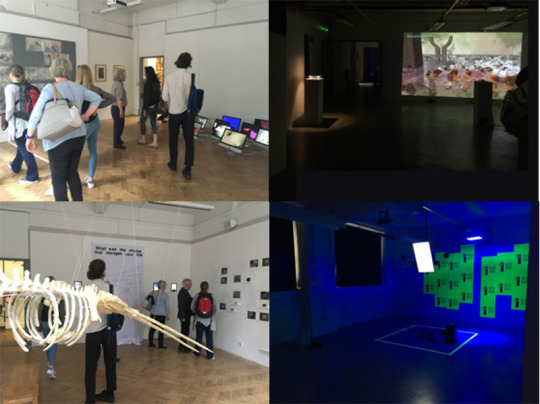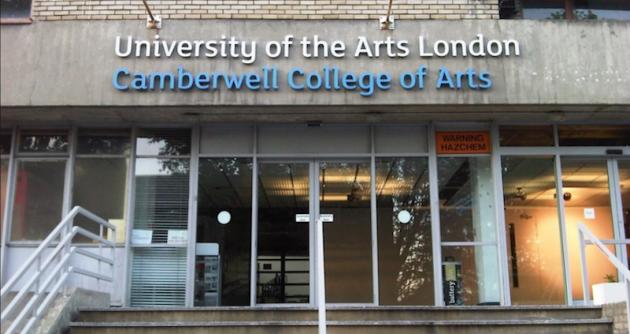This year’s Camberwell College of Arts Postgraduate Summer Show is taking place in Camberwell’s Wilson Road space. I actually think this space is a lot more open and easier to navigate than the main college.
MA Book Arts
I started by looking at MA Book Arts. Although labelled ‘book arts’, this section contained a huge variety of media including works on paper, print combined with collage, etching and photography. I can’t help feel that there is some kind of running joke with Camberwell students: we pretend to be studying one thing and then make something completely different. My understanding is that this course encourages students to challenge, explore and question what a book can be and how displaying work in different ways changes its context. This results in many conceptual interpretations of ‘the book’. An example of this process can be seen in Ines M. Ferreira’s piece, ‘A Fracking Pointless Decision’. Ines uses layers of perspex and prints on a board with large screws coming out of it. I think the piece is showing us the reverse side of fracking as we experience how the screws are disturbing the prints of rock forms. Timothy Burrough sails stacks of A4 paper with rocks on the top of them into a paper sea.

MA Printmaking
The MA Printmaking course has produced a small catalogue with all the students’ work in it making this section easy to navigate. Suwei has produced a large joining photo printed on lots of different pieces of tracing paper; it stretched across the downstairs corridor. The paper overlaps and bunches which created movement in the scene of the London underground. Helen Hayward has won two awards for her striking sculptural piece made from found objects. Luke Wade also won two awards for his beautiful and simple embossed prints. I stood and enjoyed them as a student offered me some homemade lemon balm juice. I then walked into the next room to enjoy Robert Marney’s large, intricate, shiny images of wires, buildings and machinery overlapping. I found them very interesting to look at and well put together. Xiaoqiao Li also showed some beautiful prints; I found I preferred their more abstracted work as I could appreciate more the lovely mark making. Isidora Papadouli confidently displays prints of single shapes or marks on large sheets of paper in contrast to Minami Wrigley who shows intricate prints of landscapes. Sineid Codd, whose work I have admired before, shows what looks like shiny reflective cloud shapes scattered playfully on plinths and around a sink in the corner of the room. There’s a satisfying mixture of hard and soft materials such as felt, leather and gold tinted mirror. The artist then explained her process to me. She started with an object (a brooch), then created a photograph of the object, then laser-cut from that image and now she is back to object once again. She explains that the work is scattered as this communicates the multiplicity she first felt from the brooch.

MA Illustration
Within illustration I feel a sense that this year group was very into colour. Ying Tao created psychotic, ceramic, bright faces and bowls as well as hanging dream catcher type objects with ceramic body parts hanging off them. The upstairs corridor is full of books and prints and I see that many students have explored the narrative aspect of illustration. However, there is still a huge range of ways of working; Yijun Fan’s digital imagery clearly lends itself well to animation; whereas Francesca Mclean explores printing on fabric. Jingren Wang has developed a book called ‘My Grandma Claimed That…’ with colourful, playful, dotty illustrations. Rong Li explores the behaviour of autistic kids in her project ‘My World’ which is executed in the form of prints, a book, and three small paintings on pinewood. The images create many different atmospheres even though the colour palette is limited to red and blue. Jessica Herzfeld’s prints tell a story on just two pages in a style reminiscent of Grayson Perry’s tapestries. Jiasi Lee uses printmaking methods to create brightly coloured beach scenes that mix objects and figures in imaginative and surrealist ways. Lin Jiang creates two amazing large prints that could easily work as wallpaper called ‘Barbican Conservatory’ and ‘Vacation in Nile’. In the imagery are detailed imaginative scenes observing people and places. Arturo Soto makes beautiful wooden bowls which expose the natural patterns which appear in wood. Yanfei Pan’s ‘Emotional Shadows’ is a piece made from painted glass which when the light is shining on it creates beautiful shadows. David Somers sews into canvases to create patterns which explore hybridity, mimicry, and third space. The illustration students are also running a small shop within the exhibition selling prints, ceramics, zines, books, pins, jewellery, and postcards.

MA Fine Art Digital
The work in this course explores digitalising fine art work and looking around the exhibition I discovered this could be done in many different and unconventional ways. Jiaque Huang pairs their sculpture of a skeleton with a film of people walking and interacting with the same sculpture laid down in front of the Tate Modern. This gave me the opportunity to observe the piece in a completely different context; being clambered on my pigeons and photographed and stepped over by tourists. Yvonne Opalinski shows drawings of figures playing instruments, dancing, and as part of a crowd displaying their ability to express movement in still images. Anthi Evangelou wins the Liberalist Art Award for their simple sculptures made by nailing together wood; also displayed are photographs of them being held up by nude figures. There is something very satisfying about viewing the hard wood next to the soft flesh. Downstairs more filmic work is displayed. Rhiannon Evans, who has won the Norway Residency Award, shows a glass bowl full of wrapped chocolate with a blue light shining on it. Anqi Zhou shows golden paper boats beside a video, which mixes animation with photography.

MA Designer Maker
I found the most striking work in this course was by Angelique Talbot who created a material poem by making 221 meters of hand twisted paper yarn from 32 year old maps. The yarn is hung from the ceiling and draped on the floor.

All who were involved in this exhibition should be very proud of themselves and I wish them the best in their future.
Words and photos: Florence Goodhand-Tait 2016

